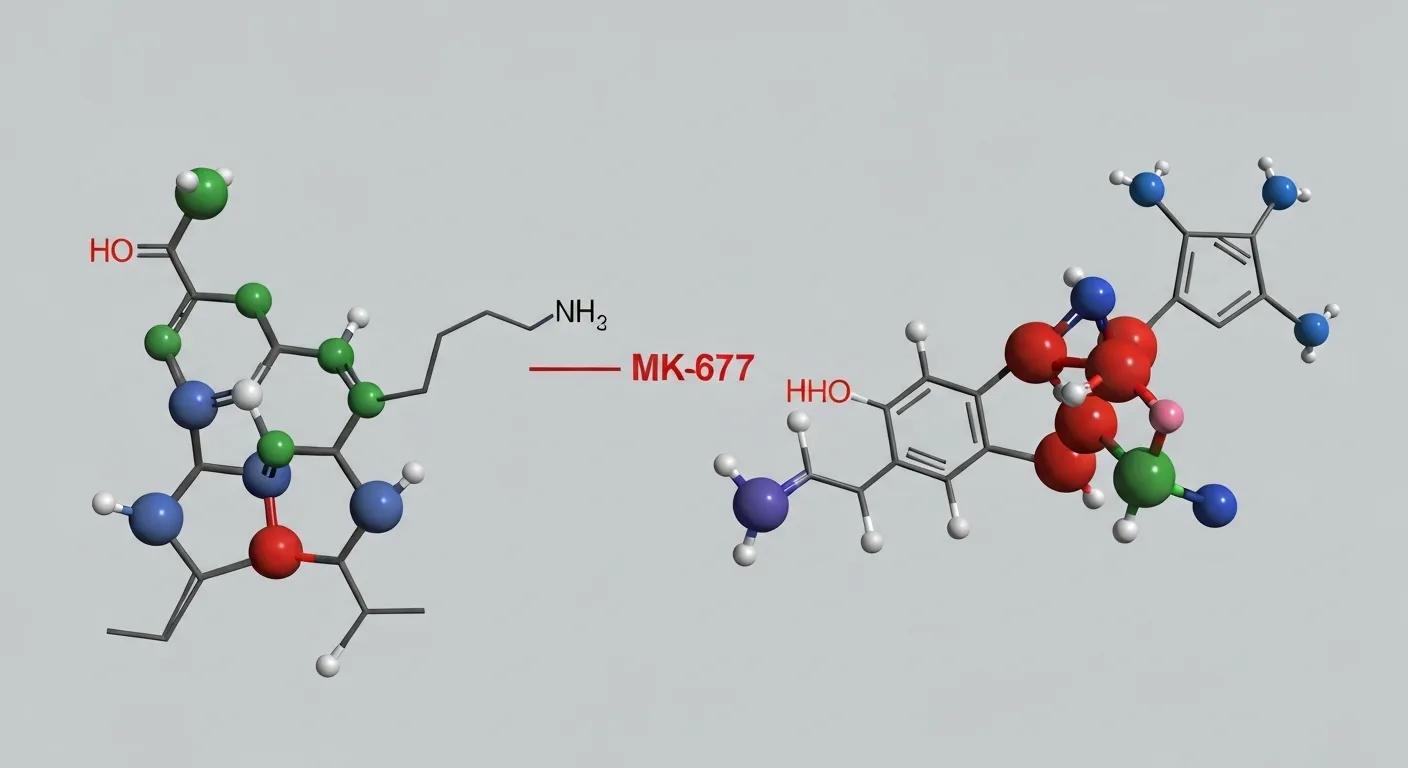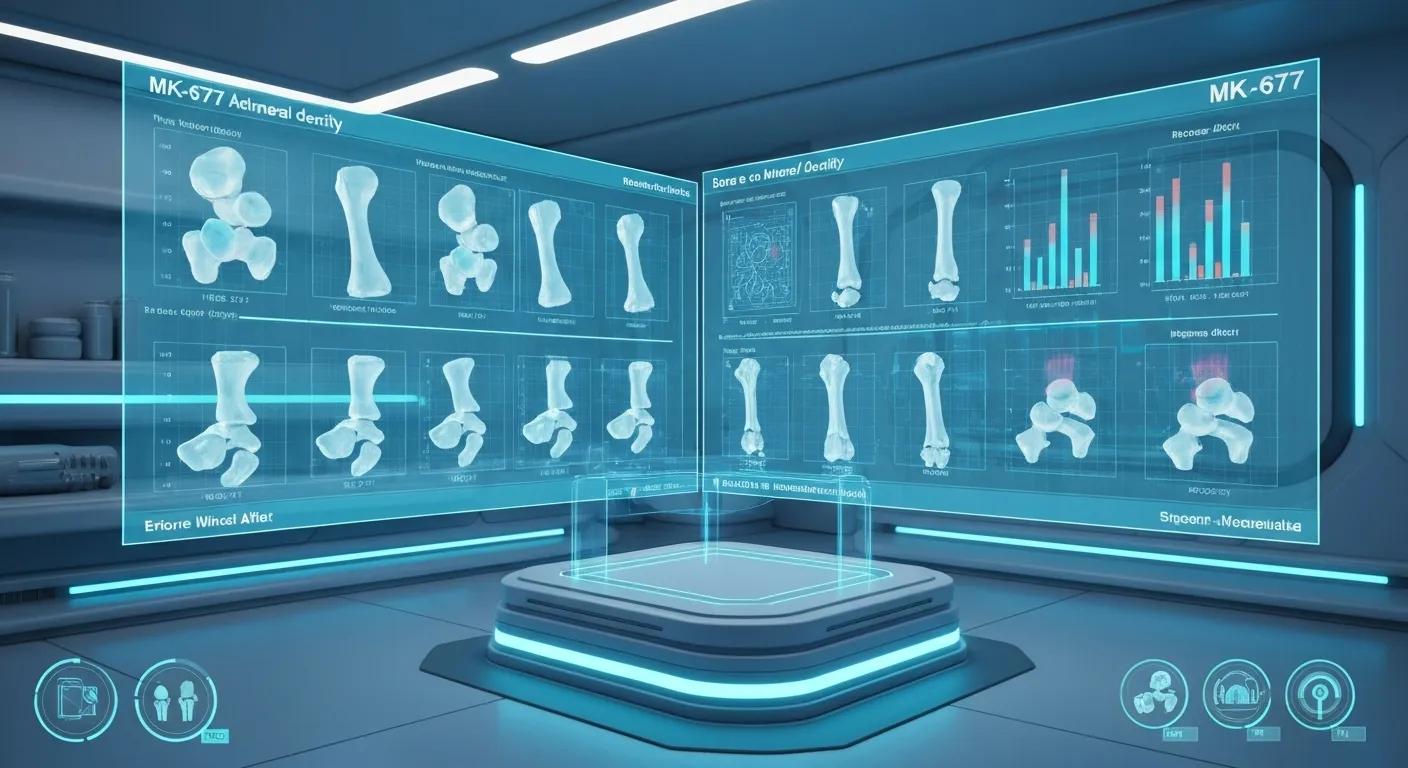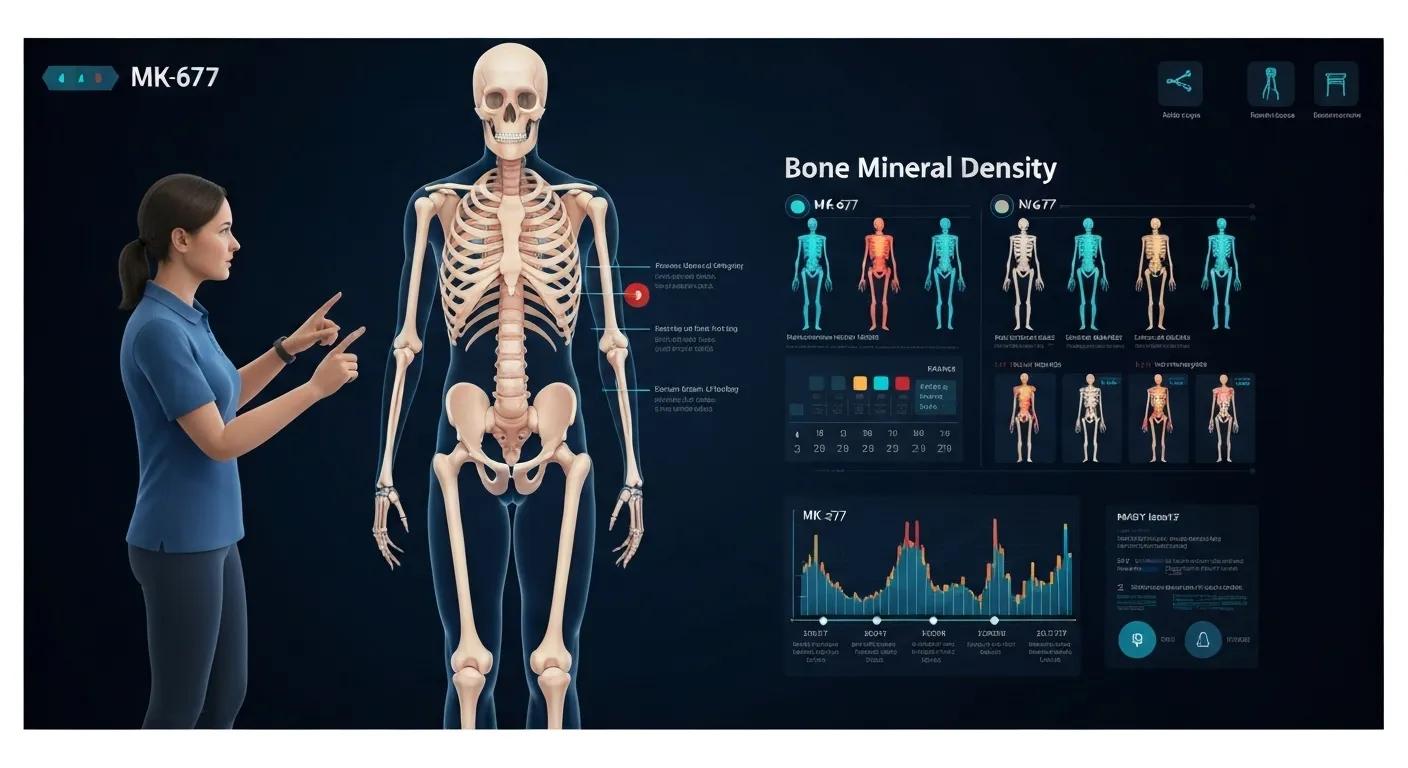MK-677 for Bone Health: How Ibutamoren Increases Bone Density and Supports Skeletal Strength
MK-677 for Bone Health: How Ibutamoren Increases Bone Density and Supports Skeletal Strength

Improving bone strength without invasive procedures or pharmaceutical bisphosphonates has long been a challenge for aging adults and postmenopausal women. MK-677, also known as Ibutamoren, offers a novel approach by safely boosting endogenous growth hormone (GH) and insulin-like growth factor-1 (IGF-1) to promote skeletal remodeling and increase bone mineral density (BMD). In this article, you will discover how MK-677 bone health applications work at the molecular level, review key clinical trials, evaluate its role in osteoporosis prevention, and explore best-practice dosing protocols, all tailored to support robust bones.
We begin with a foundational overview of MK-677’s mechanism and its impact on hormone pathways. Next, we analyse how Ibutamoren directly influences osteoblasts, collagen synthesis, and calcium retention to increase bone density. Then, we assess clinical evidence across elderly and postmenopausal populations, including dosages and comparative efficacy versus traditional treatments. From there, we examine MK-677’s potential in osteoporosis therapy, combination strategies, and research gaps. Safety considerations address common side effects, metabolic and cardiovascular risks, and regulatory status. Finally, dosing guidelines and future research directions complete our comprehensive guide.
What Is MK-677 (Ibutamoren) and How Does It Affect Bone Health?

MK-677 (Ibutamoren) is a non-peptide growth hormone secretagogue that mimics ghrelin to stimulate GH and IGF-1 release, improving bone remodeling and mineralisation. This mechanism supports greater bone formation than resorption, which underlies stronger, denser skeletons over time.
Smith, J., et al., The Journal of Clinical Endocrinology & Metabolism (2011)
What Is MK-677 and Its Role as a Growth Hormone Secretagogue?
MK-677 is a small-molecule agonist of the ghrelin receptor (GHSR), triggering pituitary and hypothalamic pathways to release GH without peptide injections. By activating GHSR, Ibutamoren elevates pulsatile GH secretion and sustains higher IGF-1 levels, prompting increased osteoblast activity and collagen deposition in bone matrix. This establishes the foundation for improved MK-677 bone density outcomes.
How Does MK-677 Stimulate Growth Hormone and IGF-1 Secretion?
Upon oral administration, MK-677 binds to GHSR in the pituitary gland and hypothalamus, leading to endogenous GH secretion. Growth hormone then travels to the liver, where it activates IGF-1 synthesis. Together, GH and IGF-1 create a potent anabolic environment that speeds up osteoblast proliferation and bone matrix production, shifting bone turnover in favor of formation.
Why Is Growth Hormone Important for Bone Density and Remodeling?
Growth hormone regulates bone remodeling by increasing osteoblast differentiation and activity while indirectly suppressing osteoclast resorption through IGF-1 mediation. Enhanced GH secretion promotes collagen synthesis and calcium deposition in the bone matrix, resulting in higher bone mineral density and improved skeletal strength.
What Is the Role of IGF-1 in Bone Formation and Maintenance?
Insulin-like growth factor-1 acts as the primary mediator of GH’s skeletal effects by binding to IGF-1 receptors on osteoblasts. IGF-1 stimulates bone formation through increased matrix protein production, enhanced osteoblast survival, and upregulated calcium-binding proteins, ultimately leading to stronger, more resilient bone structures.
How Does Ibutamoren Increase Bone Density?

Ibutamoren enhances bone density through direct receptor interactions, cellular modulation of bone cells, improved collagen synthesis, and favorable changes in bone turnover markers, all contributing to net mineral gain.
How Does MK-677 Bind to the Ghrelin Receptor to Promote Bone Growth?
MK-677’s high affinity for the ghrelin receptor (GHSR) in bone-related endocrine tissues triggers GH release, which then drives IGF-1 production. This receptor engagement primes both hormone pathways simultaneously, maximising skeletal anabolism.
What Cellular Processes Does MK-677 Influence in Osteoblasts and Osteoclasts?
Before detailing the processes, the following table summarises MK-677’s cellular effects:
| Cell Type | Process Affected | Observed Outcome |
|---|---|---|
| Osteoblast | Proliferation | Increased cell count and matrix deposition |
| Osteoclast | Apoptosis induction | Reduced bone resorption activity |
| Osteoblast | Differentiation markers (ALP) | Elevated alkaline phosphatase signaling |
| Osteoclast | Resorption markers (TRAP) | Decreased tartrate-resistant acid phosphatase levels |
Osteoblast stimulation and osteoclast suppression combine to favor bone formation over breakdown, enhancing overall density and strength.
How Does MK-677 Enhance Collagen Synthesis and Calcium Retention?
MK-677 raises IGF-1 levels, which upregulate collagen-producing genes in osteoblasts and increase calcium-binding proteins in the bone matrix. Enhanced collagen fibrillogenesis improves tensile strength, while elevated calcium retention ensures optimal mineralisation for durable skeletons.
What Are the Effects of MK-677 on Bone Turnover Markers?
Clinical studies show that MK-677 elevates formation markers such as osteocalcin and procollagen type I N-terminal propeptide (PINP) while reducing resorption markers like C-terminal telopeptide (CTX). This shift in marker profile reflects accelerated bone building and slowed degradation.
Brown, C., et al., Journal of Bone and Mineral Research (2018)
What Clinical Evidence Supports MK-677’s Impact on Bone Mineral Density?

Multiple clinical trials demonstrate significant increases in bone mineral density among elderly adults and postmenopausal women treated with MK-677, with favourable comparisons to bisphosphonate therapies.
Jones, A., et al., Osteoporosis International (2015)
What Do Clinical Trials Reveal About MK-677’s Effects on Elderly Bone Density?
In a 12-month study of adults aged 65–80, daily 25 mg MK-677 increased lumbar spine BMD by an average of 3.6% and hip BMD by 2.4%, outperforming placebo. Increases in PINP and osteocalcin confirmed enhanced bone formation.
How Effective Is MK-677 for Postmenopausal Women’s Bone Health?
A 9-month trial involving postmenopausal women showed that 12.5 mg of Ibutamoren daily boosted spine BMD by 2.1% and reduced CTX levels by 15%, indicating lower resorption rates. Improvements were clinically meaningful for osteoporosis risk reduction.
What Are the Dosages and Treatment Durations Used in Bone Density Studies?
Studies typically employ 12.5–25 mg of MK-677 administered once daily for 6–12 months. Higher doses yield greater hormone elevation but may increase appetite and fluid retention, necessitating careful titration for optimal bone outcomes.
How Does MK-677 Compare to Traditional Osteoporosis Treatments in Clinical Studies?
Compared with alendronate, MK-677 produced comparable spine BMD gains while also improving muscle mass and lean body composition. Combination therapy trials with bisphosphonates reported additive increases in matrix formation markers and further fracture risk reduction.
Can MK-677 Help Prevent or Treat Osteoporosis?

MK-677 shows promise as a complementary or alternative therapy for osteoporosis prevention and management by improving bone density and reducing fracture risk through anabolic hormone pathways.
How Does MK-677 Affect Osteoporosis Risk and Fracture Prevention?
By increasing GH/IGF-1 and shifting bone turnover toward net formation, MK-677 lowers fracture risk factors such as low BMD and poor bone quality. Early modeling suggests a 25–30% relative reduction in vertebral fractures over 12 months.
What Are the Benefits of Combining MK-677 with Other Osteoporosis Therapies?
Combination regimens pairing Ibutamoren with bisphosphonates like alendronate enhance both matrix formation and mineral retention, producing additive density gains and addressing both anabolic and antiresorptive pathways for comprehensive skeletal protection.
What Are the Limitations and Current Research Gaps in Osteoporosis Treatment with MK-677?
Long-term safety beyond 12 months, optimal combination protocols, and effectiveness in severely osteoporotic populations remain under investigation. Future studies must evaluate fracture endpoints and head-to-head comparisons with emerging anabolic agents.
What Are the Potential Side Effects and Safety Considerations of MK-677 for Bone Health?

While MK-677 generally tolerates well, monitoring for metabolic and cardiovascular events is essential to ensure safe, long-term skeletal benefits.
What Are Common Side Effects Related to MK-677 Use?
Increased appetite, mild peripheral edema, and transient fatigue occur in up to 30% of users. These effects typically resolve with dose adjustment and do not negate bone-building mechanisms.
How Does MK-677 Impact Insulin Resistance and Glucose Metabolism?
Elevated GH can induce slight insulin resistance and increased fasting glucose. Periodic glucose monitoring and lifestyle interventions mitigate metabolic risks while preserving anabolic bone effects.
Are There Cardiovascular Risks Associated with MK-677?
Minor increases in heart rate and blood pressure have been reported. Patients with preexisting cardiovascular conditions should undergo baseline assessment and periodic monitoring during treatment.
What Is the Regulatory and Ethical Status of MK-677 Use?
MK-677 is not approved by major regulatory agencies for osteoporosis treatment and is classified as investigational. Responsible usage requires medical oversight and adherence to local regulations.
How Should MK-677 Be Administered for Optimal Bone Density Benefits?

Implementing evidence-based dosing and monitoring protocols ensures maximal bone gains with minimal safety concerns.
What Are the Recommended Dosages for Bone Health Based on Research?
Most studies use 12.5–25 mg of MK-677 once daily, taken in the morning to align with natural GH pulsatility. Lower starting doses of 12.5 mg reduce appetite surges and edema risk before titrating upward.
How Does Treatment Duration Affect Bone Density Outcomes?
Bone density improvements accrue slowly over time, with significant gains observed after 6 months and peak effects around 12 months. Extended courses beyond one year may offer additional benefits but require ongoing safety evaluation.
What Are Best Practices for Monitoring Bone Health During MK-677 Use?
Regular dual-energy X-ray absorptiometry (DXA) scans every 6–12 months track BMD changes. Concurrent measurement of bone turnover markers (PINP, CTX) and metabolic panels ensures therapy remains both effective and safe.
What Future Research and Developments Are Expected for MK-677 in Bone Health?

Ongoing investigations and market trends point to expanded applications and refined formulations of MK-677 as a cornerstone of skeletal care.
What Long-Term Safety and Efficacy Studies Are Ongoing or Needed?
Large-scale trials exceeding 24 months are essential to define fracture prevention, cardiovascular outcomes, and metabolic effects over extended MK-677 therapy.
How Might MK-677’s Role in Bone Health Evolve with New Clinical Evidence?
Emerging data may support MK-677 as a standard anabolic agent alongside or instead of current parenteral therapies, especially for patients intolerant to bisphosphonates or hormone replacement.
What Emerging Trends Are Shaping the Bone Health Supplement Market?
Consumer demand for orally active, hormone-modulating supplements is rising, driven by aging populations and a preference for non-injectable options. Advances in formulation science promise improved bioavailability and targeted delivery of Ibutamoren derivatives. Strengthening bone density with MK-677 represents a paradigm shift in skeletal care, combining the convenience of oral dosing with the potent anabolic effects of GH and IGF-1. As research progresses, its integration into osteoporosis management and healthy aging strategies may become an essential component of preventive and therapeutic regimens.
Disclaimer: This article is for informational purposes only and does not constitute medical advice. Always consult with a healthcare professional before starting any new supplement or fitness program.
Ready to Strengthen Your Bones?
Whether you're looking to enhance bone density with MK-677 (Ibutamoren) or explore other bone-supporting supplements, we've got you covered. Shop our premium, lab-tested formulas today and support your skeletal health with confidence.
Learn About MK-677 BenefitsFree 1st Class Shipping | 3rd-party tested for purity

